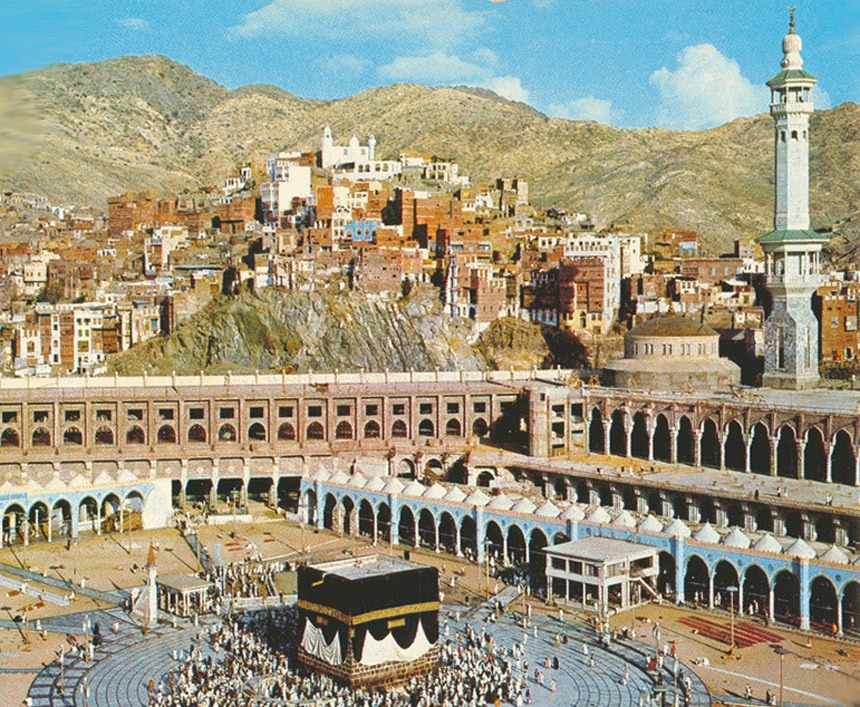Explore the enchanting Mount Abu Qubais in Makkah, KSA! Your ultimate guide for an unforgettable journey. Discover more now! 🌍🗺️
Makkah, the spiritual hub of Saudi Arabia, is not only home to the iconic Kaaba but also hosts hidden gems that beckon the adventurous traveler. Among these treasures lies the majestic Mount Abu Qubais, a haven for those seeking both spiritual and natural wonders.
MAKKAH
Me
12/16/20237 min read


Unveiling the Majesty of Mount Abu Qubais in Makkah, KSA: A Guide for Adventurous Souls 🏔️🕌
Unraveling the Wonders of Mount Abu Qubais: Your Gateway to Makkah's Tranquility 🌄🌟
Makkah, the spiritual center of Saudi Arabia, is not just home to the famed Kaaba but also boasts lesser-known gems that attract the curious traveler. Among these hidden treasures is the stunning Mount Abu Qubais, a refuge for those seeking both spiritual and natural beauty.
Islam is built on five essential pillars (Tauheed, Namaz, Zakat, Fast, and Hajj). To be a devout Muslim, one must have thorough knowledge of these pillars and the sacred scripture, the Holy Quran. Reflecting on Islamic history, we see a timeline of 124,000 prophets, each sent to guide their people to the light, and four Holy Books through which Allah SWT revealed His guidance to four blessed prophets.
From the time Adam (AS) was sent to Earth until Prophet Muhammad (PBUH) delivered his final sermon, every event has played a crucial role in establishing Islam, particularly in the Arabian Peninsula.
Despite the diverse events in Islamic history, few Muslims are aware of some common places and sites where significant events occurred across different eras. One such site is Jabal Abu Qubais.
The grand Mount Abu Qubais encompasses the Holy Kaaba in Masjid Al Haram, the sacred destination for Hajj and Umrah. While many are familiar with the story of the hills of Safa and Marwa, fewer know about Jabal Abu Qubais's importance in Islam. Continue reading to discover more about this sacred mountain.
What Is Jabal Abu Qubais?
Jabal Abu Qubais is the first mountain created by Allah SWT. The western face of Mount Abu Qubais faces the Holy Kaaba and is referred to as “Fadih.” Jabal Abu Qubais is also known as “al-Amin,” which means ‘trustworthy’ and ‘safe keeper.’
Standing at 420 meters tall, Mount Abu Qubais is situated in Makkah. It is also known as “Magharat al-Kanz,” meaning the “Treasure Cave.” It is believed that Adam (AS) stayed and was buried on this mountain, and that it witnessed the miracle of Prophet Muhammad (PBUH) splitting the moon into two halves and then rejoining them at the request of Makkah’s disbelievers.
Additionally, it is said that the mountain was named Abu Qubais after a man named Qubais who lived there in the pre-Islamic era and was the first to build a home on the mountain, leading people to refer to it by his name.
🗻 Mount Abu Qubais: A Glimpse into Tranquility
As the tallest peak in the area, Mount Abu Qubais presents an awe-inspiring view of Makkah's vast landscape. Located about 8 kilometers southeast of the Grand Mosque, this revered mountain is rich in history and holds deep religious significance.
🏰 Historical Significance: Echoes of the Past
According to legend, the Prophet Muhammad (PBUH) stood on Mount Abu Qubais and pointed towards the future location of the Grand Mosque. Today, pilgrims and visitors alike come to this elevated spot to enjoy the same view and experience the profound spiritual ambiance that fills the air.
🚗 How to Get There: Navigating the Path to Serenity
To facilitate tourist visits, a well-maintained road leads to the top of Mount Abu Qubais. Whether you opt to hire a local guide or venture on your own, the ascent promises breathtaking views of Makkah and its surroundings.
🌌 The Best Time to Visit: Embracing Nature's Beauty
To experience Mount Abu Qubais at its finest, plan your visit during the early morning or late afternoon. The changing hues of the sky against the mountainous backdrop create a magical atmosphere that will etch itself into your memory.
📸 Picture-Perfect Moments: Capture the Beauty
Make sure to bring your camera! Mount Abu Qubais is a dream for photographers, offering countless photo opportunities. From the verdant slopes to the panoramic views of Makkah, every moment is a perfect snapshot.
🧳 Practical Tips for Tourists:
1. Attire: Wear comfortable and modest clothing, especially if you plan to explore the surrounding areas.
2. Footwear: Comfortable shoes are a must, as the terrain can be uneven in certain areas.
3. Guides: Consider hiring a local guide for a richer understanding of the mountain's history and significance.
4. Water: Stay hydrated! Carry water to keep yourself refreshed during your ascent.
🌟 People's Reviews: A Glimpse into Others' Experiences
Ahmed, 28, USA: "Mount Abu Qubais was a revelation! The serenity at the top is unmatched, and the views are simply mesmerizing. A must-visit for anyone coming to Makkah."
Maria, 35, Spain: "I was skeptical at first, but the journey to the summit was worth every step. The spiritual aura and the natural beauty make Mount Abu Qubais a hidden gem in Makkah."
What Is the Importance of Jabal Abu Qubais in Islam?
Jabal Abu Qubais is a revered site that has seen some of the most significant and miraculous events in Islamic history. According to Islamic tradition, Jabal Abu Qubais is the first mountain ever created by Allah SWT.
It is the place where Allah SWT instructed Adam (AS) to construct the Holy Kaaba, and it is believed that all prophets gathered rocks from Mount Abu Qubais to build the house of Allah SWT. Furthermore, Prophet Ibrahim (AS) stood on Jabal Abu Qubais to preach, and it was from this mountain that he discovered Hajar al Aswad.
Following his call to prophethood, Prophet Muhammad (PBUH) used Mount Abu Qubais as a platform to publicly preach Islam, and it was here that he performed the miracle of splitting the moon.
Moreover, after Makkah was conquered, Bilal (RA) delivered the adhan from the top of Jabal Abu Qubais. It is also believed that the mountain once housed a small mosque called Bilal Mosque (Masjid e Bilal), which no longer exists. Today, the palace of the Saudi king stands on Mount Abu Qubais.
“The Umayyad governor Hajjaj bin Yusuf launched a catapult from Mount Abu Qubais onto the Kaaba during the siege of Makkah in 691 CE, resulting in the death of Abdullah bin Zubair (RA).”
Where Is Jabal Abu Qubais Located?
Also known as Magharat al-Kanz, Jabal Abu Qubais is located adjacent to the eastern boundary of the Holy Kaaba, Masjid Al-Haram, near Mount Safa in Makkah, within the Hejazi region of Saudi Arabia. It is 441.5 kilometers from Madinah.
Facts about the Mountain of Abu Qubais
Islamic literature is abundant with stories about various places, stones, mountains, and miracles. To gain a deeper understanding of the religion, it is crucial to study these elements. As time progresses, the Earth’s topography has witnessed many miracles. Here are three lesser-known facts about Jabal Abu Qubais:
Prophet Ibrahim (AS) Preached Islam Atop This Mountain As one of the tallest peaks of that era, it was from the summit of Jabal Abu Qubais that Prophet Ibrahim (AS) conveyed Allah SWT's message to his people.
Hajar al Aswad Was Kept on This Mountain An intriguing fact about Mount Abu Qubais is that during the great flood in Nuh’s (AS) time, which inundated Makkah and the Holy Kaaba, Jabal Abu Qubais served as the resting place for Hajar al Aswad (the Black Stone).
The narrative continues with Allah SWT directing Prophet Ibrahim (AS) to rebuild the Holy Kaaba. It was then that Allah SWT guided him to Jabal Abu Qubais to locate the hidden Hajar al Aswad. Prophet Ibrahim (AS) was informed that Hajar al Aswad was no ordinary stone but one that descended from Jannah and should be placed in the Holy Kaaba.
Another account suggests that Angel Jibreel (AS) lifted the stone from Mount Abu Qubais after the flood and later gave it to Prophet Ibrahim (AS) during the Kaaba's reconstruction.
If both accounts are accurate, the story aligns as follows: During the flood, Angel Jibreel (AS) placed Hajar al Aswad securely within Mount Abu Qubais. Later, when Allah SWT commanded Prophet Ibrahim (AS) to rebuild the Kaaba, Angel Jibreel (AS) descended and showed Ibrahim (AS) the location where Hajar al Aswad was hidden on Mount Abu Qubais.
Prophet Muhammad (SAW) Miraculously Split the Moon into Two Pieces Many are familiar with the incident where disbelievers requested Prophet Muhammad (PBUH) to perform the miracle of splitting the moon
🌈 In Conclusion: A Journey of Spiritual Bliss and Natural Splendor
Mount Abu Qubais in Makkah, KSA, is more than just a geographical elevation; it's a sanctuary for the soul. From its historical significance to the awe-inspiring views, this mountain promises an experience that transcends the ordinary. Pack your bags, embark on this adventure, and let the spirit of Mount Abu Qubais captivate your heart.
So, when are you planning your visit to this majestic peak?
FAQs
What is Mount Abu Qubais?
Mount Abu Qubais is the tallest mountain in Makkah, Saudi Arabia, known for its religious significance and historical relevance. It offers breathtaking views of the city and is located southeast of the Grand Mosque.
What is the religious significance of Mount Abu Qubais?
to Islamic tradition, Mount Abu Qubais is the first mountain created by Allah and is known for witnessing several miracles, including Prophet Muhammad (PBUH) splitting the moon and Prophet Ibrahim (AS) discovering Hajar al Aswad (the Black Stone) from this mountain.
Why is Mount Abu Qubais important in Islamic history?
It is believed to be the site where the Prophet Muhammad (PBUH) publicly preached Islam and performed the miracle of splitting the moon. It is also said to be the place where rocks for constructing the Kaaba were collected.
Is there an entrance fee to visit Mount Abu Qubais?
No, there is no entrance fee to visit Mount Abu Qubais. It is open to all visitors.
How can I get to Mount Abu Qubais?
A well-maintained road leads to the summit of Mount Abu Qubais, making it accessible by car or on foot. Hiring a local guide is recommended for a more enriched experience.
What is the best time to visit Mount Abu Qubais?
The best times to visit are early in the morning or late in the afternoon to witness the beautiful sunrise or sunset, which adds to the mountain’s tranquil atmosphere.
Can Mount Abu Qubais be visited during Hajj?
Yes, Mount Abu Qubais is accessible year-round, but it is recommended to visit outside the Hajj season for a more peaceful and less crowded experience.
What are some of the key historical events associated with Mount Abu Qubais?
Mount Abu Qubais is believed to have been the location from where Prophet Ibrahim (AS) preached, where the Black Stone was hidden after the great flood, and where Prophet Muhammad (PBUH) split the moon.
Are there any facilities for prayer on Mount Abu Qubais?
Yes, there are designated prayer areas at the summit for visitors who wish to pray or reflect.
Is there any specific attire recommended for visiting Mount Abu Qubais?
Visitors are advised to wear modest and comfortable clothing due to the spiritual nature of the site, and comfortable footwear for walking on uneven terrain.
Links
Socials
Subscribe to our newsletter


KSA Journeys is dedicated to showcasing the very best of Saudi Arabia’s destinations from its awe-inspiring natural landscapes to its rich cultural heritage. Our mission is to provide travelers with an easy, enjoyable, and immersive experience as they explore the Kingdom’s most iconic sites, hidden gems, and spiritual landmarks. Whether you're seeking adventure, relaxation, or cultural discovery, KSA Journeys is your trusted companion for unforgettable travel in Saudi Arabia.
Use full Links
Contact Us



